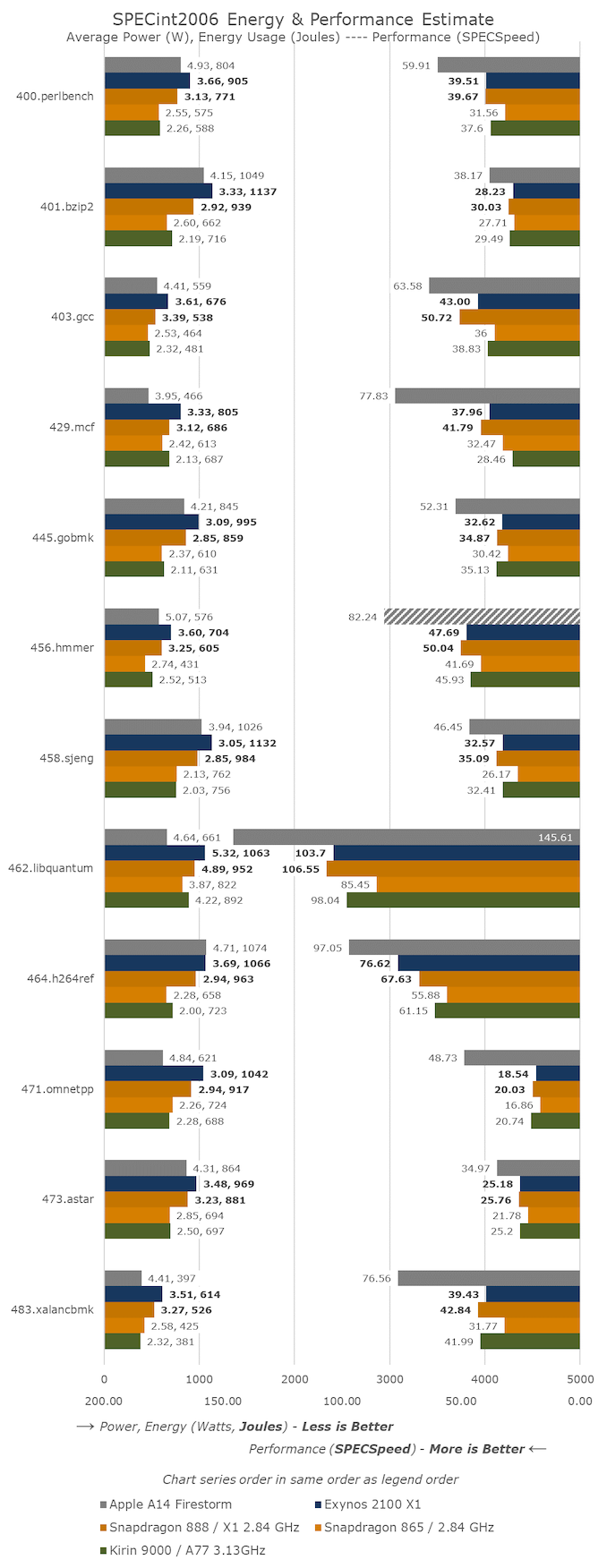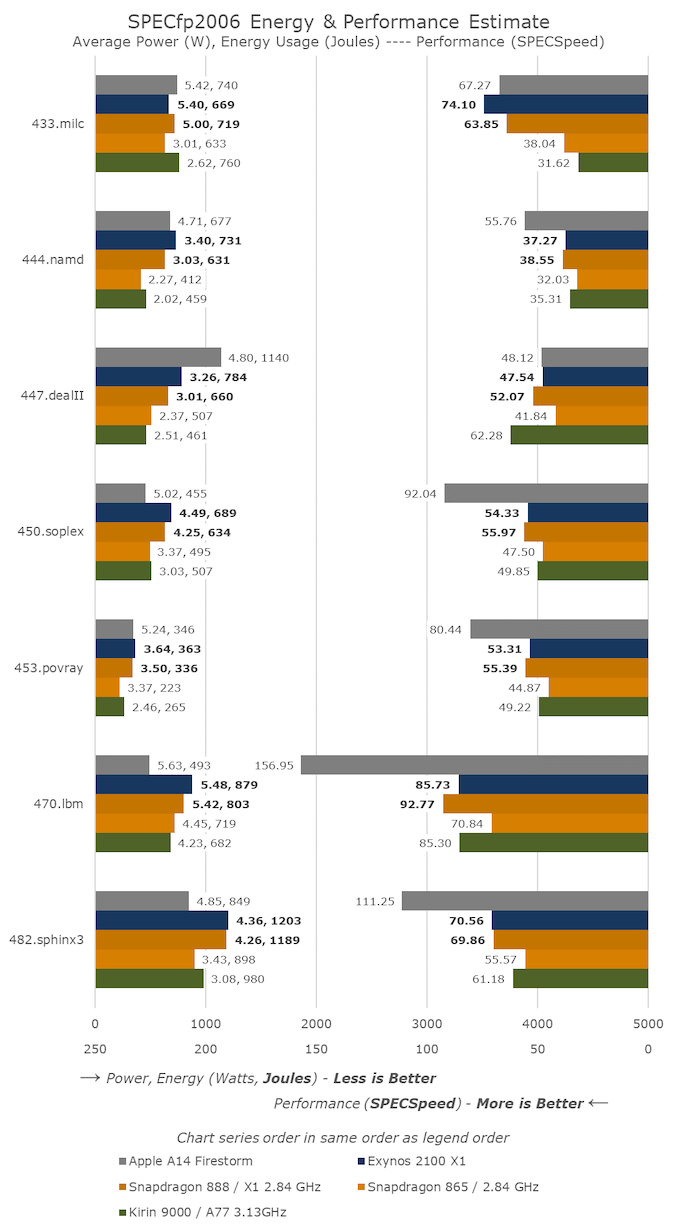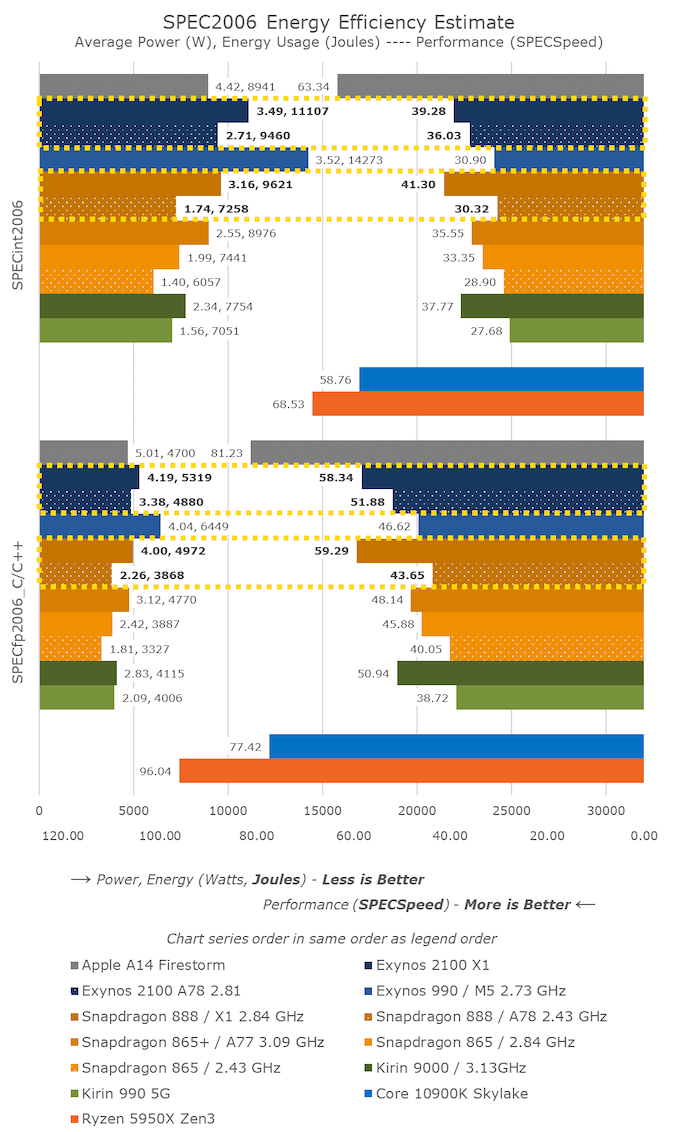The Snapdragon 888 vs The Exynos 2100: Cortex-X1 & 5nm - Who Does It Better?
by Andrei Frumusanu on February 8, 2021 3:00 AM EST- Posted in
- Mobile
- Samsung
- Qualcomm
- Smartphones
- SoCs
- Snapdragon 888
- Exynos 2100
SPEC - Single Threaded Performance & Power
Moving onto performance of the new CPU cores, something I’ve actually been quite excited about this generation, particularly because this year we hadn’t been able to do a proper in-depth performance preview of the Snapdragon 888 like we usually do on previous years.
Before we go into the results, I wanted to point out some discrepancies between the Exynos 2100 and Snapdragon 888 Galaxy S21 Ultra devices, particularly regarding clock frequencies under load: I’ve noted that the Exynos 2100 CPUs are extremely prone to throttling, in a quite drastic fashion compared my Snapdragon 888 unit. When tracking the average frequencies under SPEC, benchmarking the Exynos 2100 S21 Ultra under my typical peak performance conditions where I place the phone over a 140mm fan to keep it cool, the X1 cores were still throttling quite significantly even though the phone was only luke-warm.
The following are precise mean frequencies for the SPEC workloads, both under my usual fan-cooled conditions, as well as putting the S21 Ultra in my freezer:
| Cortex-X1 Average Workload Frequency | ||||
| S21 Ultra (Exynos 2100) Fan |
S21 Ultra (Exynos 2100) Freezer |
S21 Ultra (Snapdragon 888) Fan |
||
| 400.perlbench | 2613 | 2845 | 2826 | |
| 401.bzip2 | 2690 | 2904 | 2841 | |
| 403.gcc | 2688 | 2905 | 2839 | |
| 429.mcf | 2744 | 2912 | 2841 | |
| 445.gobmk | 2701 | 2908 | 2841 | |
| 456.hmmer | 2534 | 2752 | 2841 | |
| 458.sjeng | 2684 | 2912 | 2841 | |
| 462.libquantum | 2469 | 2857 | 2841 | |
| 464.h264ref | 2602 | 2901 | 2841 | |
| 471.omnetpp | 2756 | 2912 | 2842 | |
| 473.astar | 2667 | 2909 | 2841 | |
| 483.xalancbmk | 2668 | 2909 | 2841 | |
| 433.milc | 2369 | 2759 | 2842 | |
| 444.namd | 2603 | 2912 | 2841 | |
| 447.dealII | 2721 | 2889 | 2841 | |
| 450.soplex | 2573 | 2883 | 2841 | |
| 453.povray | 2544 | 2769 | 2841 | |
| 470.lbm | 2273 | 2628 | 2812 | |
| 482.sphinx3 | 2437 | 2709 | 2747 | |
The fan-cooled results are quite horrible, with the chip not sustaining the full 2.91GHz for any of the workloads. In this situation, in fact most of the tests barely run at 2912MHz, with most of the time the X1 cores being resident at 2600 or 2496MHz, with many tests going down to 2184MHz for periods of time.
Putting the device in the freezer (with a sock around the bottom part of the phone as to not damage the battery from it getting too cold), resulted in skin temperature hot-spots of around 6 to 10°C. Even under such unrealistic test conditions, the phone wasn’t able to sustain its peak frequency for many workloads, which is quite puzzling and worrying.
This Exynos S21 Ultra unit was quite unlucky in terms of its chip bin as the CPUs received ASV bins of 2, 2, 2 across the little, middle, and big cores. I’ve got another regular Galaxy S21 with another Exynos chip, which had slightly better bins of 4, 4, 3. While this device performed better and was slightly more efficient than the S21 Ultra, it was still significantly worse than the Snapdragon 888 Galaxy S21 Ultra, which had no issues to sustain near its 2841MHz peak frequency for the vast majority of workloads.
The following results are from the freezer-run Exynos S21 Ultra, as we’re attempting to analyse peak performance and the X1 cores themselves as well.
We use SPEC2006 for mobile devices still as it’s still relevant and we have a good understanding of the workloads. The benchmark is deprecated in favour of SPEC2017, which we hope to move to in the coming months. For the Android devices, this data-set is on a new NDK 22 compile as it resolves some performance discrepancies in our past data. We run simple and straightforward -Ofast flags.
In SPECint2006, we can see the new Cortex-X1 cores in both the Snapdragon 888 and Exynos 2100 perform a notch above the previous generation A77-cores, with particularly some larger jumps in tests such as 403.gcc and 464.h264ref.
The Snapdragon 888 in the majority of tests is able to take the lead, even though for the integer benchmarks the Exynos 2100 was mostly able to retain frequencies near 2.9GHz.
Qualcomm’s lower latency memory subsystem, as well as the advantage of the 1MB L2 cache are quite obvious here as it’s able to overcome, and outpace the clock frequency differences.
It’s to be noted that HiSilicon’s Kirin 9000 is still able to keep up with the new chips in quite a few of the workloads – the Kirin’s 3.13GHz clock frequency as well as an outstanding memory subsystem fall in its favour.
In terms of power and efficiency, it’s very obvious that the Exynos 2100 falls behind the Snapdragon 888. The chip uses more power, and it being slower, means it’s also taking up more energy to complete the tasks.
In SPECfp2006, the Exynos 2100 actually manages to score a few wins against the Snapdragon 888, but again falls behind in others as it has to throttle.
In 433.milc, the new X1 chips are posting gargantuan generational performance bumps, but which comes at a cost of power consumption in excess of 5W – whatever Arm did here this generation, it caught up and surpassed Apple in this one test.
For more extensive performance comparisons to past SoCs, such as the Exynos 990 I’ve updated our historical SPEC mobile data-set in the above large graph.
In the aggregate results scores, there’s a multitude of points we need to analyse.
Starting off with the Exynos 2100 – generationally, the new X1 cores and the Exynos 2100 are able to beat the Exynos 990 and the M5 cores by 27% and 25% in the integer and floating-point results. Samsung had officially stated the new SoC would be 19% faster in single-threaded scenarios – which I immediately throught of as suspect, as the improvements should be larger than that. I’m glad that the marketing was overly conservative and that my initial instinct was correct here. Although the X1 cores don’t use much different power consumption compared to the M5 cores, because of their increased performance, they are more energy efficient, using 23% and 18% less energy than the M5.
Looking at those figures though, they seem quite a bit odd, as they’re not that great as we had expected from the X1 cores, especially since this is also on a process node upgrade. Wouldn’t the cancelled M6 cores still have been competitive here?
The Snapdragon 888 results put things into context – it’s 5.1% and 1.6% faster than the Exynos 2100, however it’s also less power hungry, using 10% less power, resulting in being 14% more energy efficient. That’s not a large difference, but still sizeable given it’s the same CPU IP on the same process node.
Against the Snapdragon 865, the Snapdragon 888’s X1 cores are 23.8% and 29.2% faster. Because the cores are clocked at the same frequency, that’s also the generational IPC improvement that we’ve seen out of the new X1 cores. On the floating-point side, that essentially matches Arm’s 30% projection, however on the integer side it’s a few percentage points short – which is reasonable given that Arm’s figures had been projected with an 8MB L3 cache implementations which we didn’t see this generation.
Energy efficiency of the Snapdragon 888 is only slightly worse than that of the Snapdragon 865+, which means that battery life should still be good this generation.
The Cortex-A78 cores of the Snapdragon 888 are 4.9% and 8.9% faster than the Cortex-A77 middle cores of the Snapdragon 865. The power consumption comparison here isn’t apples-to-apples due to the new cores doubling up on the L2 cache. Arm states the A78 has an +7% IPC improvement and a -4% power reduction versus the A77. The Snapdragon 888’s middle cores however use +24% more power. Excluding the theory that that doubled L2 cache significantly raises power, we’re probably still seeing a notable process node power efficiency difference between Samsung’s 5LPE node and TSMC’s N7P node, with the Samsung node still falling behind.
This power efficiency difference can also be seen in the Cortex-A78 cores of the Exynos 2100. At 2.81GHz, they’re near the 2.84GHz A77 cores of the Snapdragon 865 – both having 512KB L2 caches. The Exynos’ middle cores here actually outperform the previous Snapdragon’s performance cores by 8 and 13%, they however use 35% more power to do so, which is a whole damn lot. In fact, the throttling behaviour on the Exynos wasn’t just limited to the X1 cores, as under normal conditions even these middle A78 cores had to ramp down from their peak frequencies.
This behaviour of these new designs using quite large amounts of power at these higher frequencies, however being seemingly similar power to TSMC’s process nodes at lower frequencies, points out to me that the 5LPE node has lower performance than TSMC’s N7P node. The fact that the Kirin 9000 here is still competitive in terms of performance, but at significant lower power and better energy efficiency, also points out that the N5 node is well superior to Samsung’s offering.
Generally, we can’t do much about the process – especially if TSMC isn’t able to produce enough volume to satisfy both Apple as well as Qualcomm at the same time. Today’s performance and efficiency figures also fell below our projected targets of the X1 cores. Lower frequencies and smaller caches are primary reasons as to why. I find it weird from both Qualcomm as well as SLSI to have employed 4MB L3 caches. SLSI has in the last few years wasted a ton of silicon on their custom cores, so them skimping out even on the L2 cache here on the X1 is a really weird change of philosophy. Qualcomm did a better job, but also not as aggressive as you’d expect from a company which wants to acquire Nuvia in order to strengthen their CPU portfolio.














123 Comments
View All Comments
Andrei Frumusanu - Tuesday, February 9, 2021 - link
I don't have 5G coverage here so it's not feasible for me to test.Edwardmcardle - Wednesday, February 10, 2021 - link
Will you be testing reception differences e.g. 4g and wifi? Fantastic write up as always!Dorkaman - Tuesday, February 9, 2021 - link
Different s21 ultra phones can have different performance says tech chaphttps://youtu.be/yuNNmf2gIRc
I guess this is due to binning and his tests show his Exonys 2100 is in the middle. Strange. Also, the battery life is better on the 888 and external temps are about the samd.
serendip - Tuesday, February 9, 2021 - link
All this really doesn't look good for Windows on ARM if we're stuck with hot and hungry Qualcomm chips on Samsung 5nm. The 8cx and SQ on TSMC 7nm were very efficient but that's with slower A76 cores. I'm hoping a quad-X1 design on TSMC 5nm will be in the next iteration of the Surface Pro X or Galaxy Book S.Raqia - Tuesday, February 9, 2021 - link
Disappointing sustained performance, however the S21 series lacks the phase change vapor chamber cooling solution of the S20's:https://9to5google.com/2021/01/18/samsung-galaxy-s...
vs
https://www.ifixit.com/News/43501/why-samsung-buil...
Notably the Mi11 has this:
https://gadgettendency.com/a-triple-chamber-as-a-s...
This makes for better subsequent runs but the SoCs built on 5LPE are still disappointing.
iphonebestgamephone - Wednesday, February 10, 2021 - link
Mi 11 may have the vapor chamber for better cooling, but it also allows for a higher battery temperature. If they throttled at the same temps we could see how useful that thing actually is.dudedud - Wednesday, February 10, 2021 - link
Not all S20s had that vapor chamber. Some just had a graphene layer, which in theory would give similar results. Don't know if the S21 uses graphene tho.darkich - Wednesday, February 10, 2021 - link
The battery life benchmarks are indication of how actually invalid the whole Anantech's premise is.Pretty much ALL actual real usage tests have shown BIG improvements in the autonomy between the S20/S21 yet Andrei wants us to believe in the stupid benchmark test that shows "regression" between Exynos 990 and Exynos 2100.
What a joke..
ChrisGX - Sunday, February 14, 2021 - link
I would say these results are incomplete rather than invalid. The PCMark Work 2.0 - Battery Life test is a demanding mixed usage benchmark. When running that benchmark it isn't exactly a shock that the Exynos 2100 S21 Ultra should return very slightly reduced battery life than the Exynos 990 S20 Ultra. Anandtech isn't alone in noting that when processing demanding workloads the Exynos 2100 draws more power (on average) than the Exynos 990. Andrei, for his part, is explicit that the Exynos 2100 is also significantly more performant than its predecessor. He does say that the increased performance wasn’t just achieved through improved efficiency, but also through greater power usage and it is hard to dispute that looking at the numbers.There is a gap in the data however. The full PCMark Work 2.0 - Battery Life test involves a Work performance score that gives a more complete picture of how much work/the rate that work is being completed while executing the test. That would be very useful information to have. Still, it is undoubtedly the case that the reduction in battery life that Andrei mentions is not due to a regression but rather the increased rate that the Exynos 2100 is executing work (when processing demanding mixed usage workloads). While that information isn't provided in connection to the PCMark Work 2.0 - Battery Life test the GFXBench GPU heavy test data (arranged in Power Efficiency tables) does confirm the high power draw of the Exynos 2100 during peak performance bursts (which must bump up average power consumption as well) even as that chip roundly outperforms the Exynos 990.
Indeed, heavy mixed usage workloads are not going to put the Exynos 2100 battery life in the best light. Still, Andrei did show the results from a Web Browsing Battery Life test that undoubedly will be useful to a lot of phone users who don't view the results of the PCMark Work 2.0 - Battery Life test as having a lot of relevance for them. But, I, for one, am happy to have that information.
Andrei seems to be adding to/reworking the battery life data in this review.
https://benchmarks.ul.com/pcmark-android
https://s3.amazonaws.com/download-aws.futuremark.c...
sachouba - Wednesday, February 10, 2021 - link
Nice peak power consumption!It doesn't seem unlikely that we'll end up with a situation similar to Apple's battery gate on Snapdragon 888 devices, in a few years. Way to go!